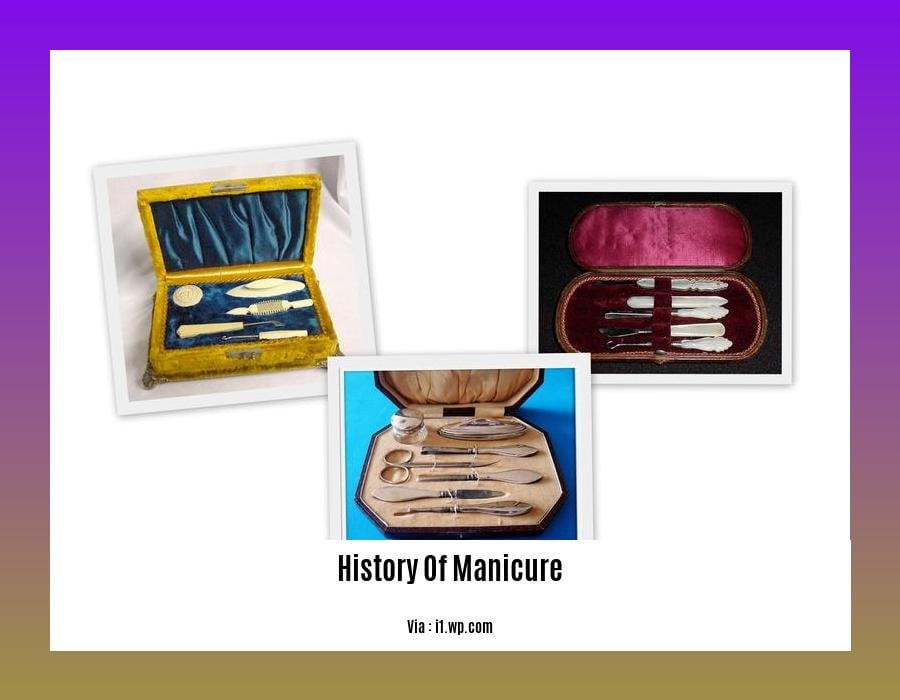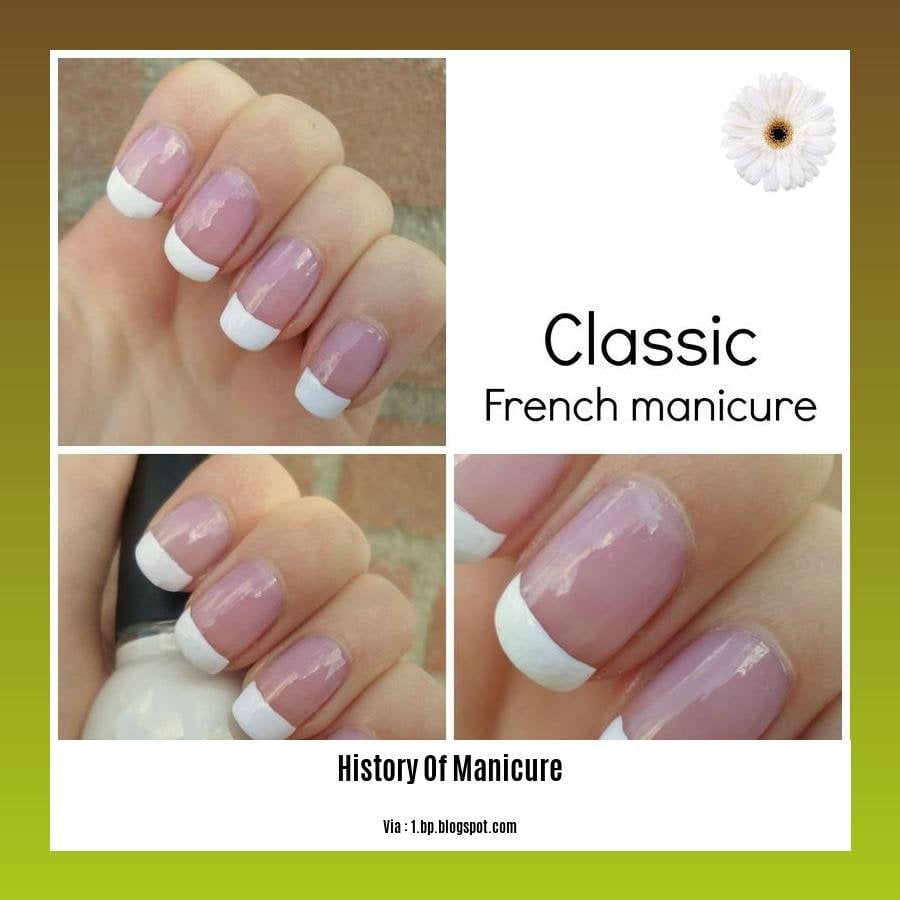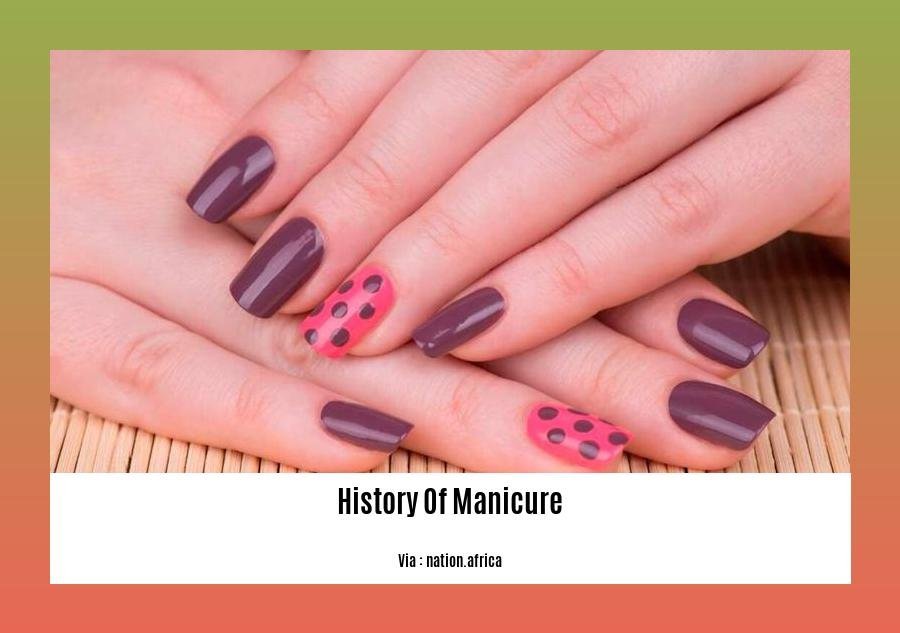Unveiling the rich tapestry of nail artistry, [- Tracing the History of Manicures: A Journey Through Styles and Cultural Significance] embarks on an enthralling voyage into the captivating world of manicures, where elegance, aesthetics, and cultural expressions harmoniously converge.
Key Takeaways:
Solid gold manicure set unearthed in ancient Babylonia (circa 3,200 BC) highlights the longstanding significance of nail care in human civilization.
Nail grooming held cultural importance in ancient societies, symbolizing cleanliness and beauty in Egypt, Babylonia, and China.
Revealing the Alluring History of Manicures: A Journey of Beauty, Hygiene, and Cultural Norms

Throughout human history, the art of manicures has evolved into a symbol embodying much more than just aesthetics. Delving into ancient origins, let’s embark on a captivating journey to explore how manicures flourished into a widespread cultural phenomenon.
Dawn of Manicuring: When Beauty Met Hygiene
Nail care practices date back to ancient Babylonian women adorned with jewelry adorning intricately painted nails for the sake of distinction. It wasn’t just decorative, it was a status symbol, indicating their societal rank.
In ancient Egypt, manicures held spiritual significance. Nail growth was associated with vitality and the afterlife, with lavishly polished nails showcasing honor for the immortal Gods.
Cultural Expressions Through Painted Nails
In ancient China, fingernails, particularly those of the wealthy, were painted in vibrant hues using beeswax, tree sap, and natural dyes. This was an emblem of social status, with fashionable lengths and elaborate designs reflecting their social prestige.
During the Ming Dynasty, men of distinction followed the trend, opting for black or red nail polish to display their power and status.
The European Renaissance: When Beauty Flourished
Nail care in Renaissance Europe reflected the era’s artistic and lavish lifestyle. Beauty standards evolved, with oval-shaped nails becoming fashionable.
In the 18th century, manicures became a symbol of hygiene, with nail care and cleanliness emphasized in societal etiquette.
The Rise of Modern Manicures: A Cultural Phenomenon
The 20th century witnessed the modern manicure’s birth, with numerous advancements and trends. The invention of artificial nails, gel polish formulas, and nail art techniques revolutionized the industry.
Today, the beauty and cultural significance of manicures endure. Whether it’s for fashion, self-expression, or personal hygiene, well-manicured nails have become an integral part of our lives.
Conclusion: Manicures Through the Sands of Time
The history of manicure weaves a captivating narrative of how this ancient practice evolved into a modern cultural icon. What began as a symbol of status and hygiene has transformed into an art form and a powerful expression of individual style.
Manicures have become a global phenomenon, transcending cultural boundaries and serving as a reflection of our ever-evolving societal norms.
- For a comprehensive exploration of the evolution of the magazine industry in India, delve into the detailed history history of magazines in india.
- Discover the rich cultural heritage and captivating history behind the traditional Filipino folk dance, Maglalatik, in this informative article history of maglalatik folk dance.
- Embark on a fascinating journey through the history of manicure and pedicure, from their ancient origins to modern-day practices, in this comprehensive account history of manicure and pedicure.
- Gain insights into the evolution of marketing strategies and techniques over the years, from traditional approaches to contemporary digital practices, in this informative exploration of history of marketing ss1.
Evolution of Manicure Techniques: From Ancient Tools to Modern Equipment

Since time immemorial, manicures have symbolized more than just aesthetics; they have been intrinsically linked to cultural norms and societal status. Indulge in a journey through the ages, where we trace the fascinating evolution of manicure techniques.
Ancient Roots: Embracing Natural Beauty
In ancient civilizations like Babylonia, Egypt, and China, nail care held immense significance. The Chinese, renowned for their ingenuity, introduced the world to nail polish around 3000 BC, a testament to their enduring pursuit of beauty. In those times, nail care tools were crafted from natural materials such as gold (for nail clippers) and orangewood (for cuticle sticks). This era was characterized by a focus on filing, shaping, and polishing nails to achieve a neat and healthy appearance.
Manicures as Symbols of Status and Wealth
In ancient times, a well-manicured hand was a symbol of wealth, status, and beauty. Longer nails were associated with higher social standing, and intricate designs were reserved for special occasions. Nail art, though not as elaborate as today, was prevalent in some cultures, with women adorning their nails with natural dyes and pigments.
Technological Advancements: Transforming Nail Care
The advent of acrylic nails and gel polish in the 20th century revolutionized the manicure industry. Acrylic nails offered strength and length, catering to those desiring a dramatic look. Gel polish, with its long-lasting and chip-resistant formula, became a popular alternative to traditional nail polish.
Nail Art: A Canvas for Creativity
As manicures became more accessible, nail art emerged as a form of self-expression. From simple designs to intricate patterns, nail art became an integral part of the manicure experience. Today, it’s not uncommon to see nails adorned with rhinestones, glitter, and 3D embellishments, reflecting the wearer’s creativity and personal style.
Manicures for Health: Beyond Aesthetics
While aesthetics remain a primary focus of manicures, contemporary nail care practices emphasize foot and hand health. Manicures now incorporate techniques to address common nail problems like hangnails or ingrown toenails. Additionally, there’s a growing awareness of the importance of proper hand and foot hygiene, making manicures an essential part of overall well-being.
Key Takeaways:
- Cultural Symbolism: Throughout history, manicures have held cultural significance, symbolizing wealth, status, and beauty.
- Ancient Origins: Nail care practices date back thousands of years, with ancient civilizations using natural tools and techniques.
- Technological Advancements: The introduction of acrylic nails and gel polish revolutionized the industry, expanding the range of options.
- Nail Art as Expression: Manicures became a canvas for creativity, allowing individuals to express their personal style through nail art.
- Health and Hygiene: Contemporary manicures emphasize foot and hand health, promoting proper hygiene and addressing common nail problems.
Sources
- Nail Polish History 101: Evolution of Manicure Over the Years
- A History of Nails – Industry News – NAILS Magazine
Fashion and Manicures: The Influence of Trends on Nail Design
Throughout history, manicures have evolved as an integral part of fashion, reflecting cultural shifts and individual styles. From ancient Egypt’s elaborate designs to the modern era’s diverse nail art trends, manicures have served as a canvas for self-expression and a symbol of societal influence.
Ancient Elegance: A Display of Status
In ancient Egypt, manicures held spiritual and societal significance. Lavish nail art adorned with intricate hieroglyphs and vibrant colors showcased a woman’s status and honor. Similarly, in ancient China, long, painted nails symbolized wealth and prestige, with elaborate designs reserved for the upper classes.
Renaissance Refinement: Cleanliness and Grace
The Renaissance period saw a shift towards hygiene and cleanliness. Well-manicured nails became a symbol of good hygiene and social etiquette. Oval-shaped nails were fashionable, reflecting the era’s artistic and lavish lifestyle.
Modernization and Innovation: A Canvas for Creativity
The 20th century witnessed groundbreaking innovations in the world of manicures. Acrylic nails, gel polish formulas, and nail art techniques revolutionized the industry, allowing for longer-lasting and more creative nail designs. The 1950s marked the birth of modern nail art, with celebrities like Cher and Madonna popularizing elaborate nail designs.
In the 1970s and 1980s, nail art became a symbol of self-expression, with a wide range of designs and techniques emerging. From simple polish changes to intricate works of art, nail art became a way to showcase individuality and creativity.
The 1990s introduced the classic French manicure, which remains popular today for its timeless elegance. The early 2000s brought the trend of gel nails, offering a durable and chip-resistant finish.
Today, manicures have become an essential part of modern fashion, allowing individuals to express their personal style and creativity while maintaining a sense of cleanliness and hygiene.
Key Takeaways:
Manicures have evolved from ancient times, holding cultural and societal significance.
In ancient Egypt and China, elaborate nail designs indicated status and wealth.
The Renaissance period emphasized cleanliness and hygiene, with manicures becoming a symbol of good grooming.
The 20th century brought innovations like acrylic nails and gel polish, revolutionizing the industry.
Modern nail art is a canvas for self-expression, allowing individuals to showcase their creativity and personal style.
References:
Harper’s BAZAAR:
The Guardian:
Male Manicures: A History of Breaking Gender Norms
From ancient warriors to modern celebrities, men have adorned their nails with flair and creativity throughout history. Male manicures have evolved from symbols of power and status to expressions of individuality and style, challenging traditional gender norms and redefining masculinity.
Key Takeaways:
In ancient Egypt, men adorned their nails with henna as a symbol of power and wealth.
During the Ming Dynasty, wealthy Chinese men opted for black or red nail polish to showcase their social status.
In the 20th century, male manicures gained popularity among celebrities and performers, such as rock stars and actors.
Today, men from all walks of life embrace manicures as a form of self-expression, breaking down gender stereotypes.
Male manicures have become increasingly popular in recent years, as more men embrace self-care and challenge traditional notions of masculinity.
The Rise of Male Manicures: A Cultural Shift
In the past, nail care was often seen as a feminine pursuit, but societal attitudes towards male manicures have shifted dramatically in recent years. Male celebrities like Harry Styles, A$AP Rocky, and Machine Gun Kelly have challenged traditional gender norms by embracing manicured nails, inspiring many men to follow suit.
This cultural shift is driven by a growing acceptance of diverse expressions of masculinity and a desire among men to take control of their appearance and self-care routines. Male manicures are no longer seen as a sign of vanity but rather as a form of self-expression and personal style.
The Future of Male Manicures: Breaking Down Barriers
As societal norms continue to evolve, male manicures are poised to become even more popular and accepted. With more men embracing self-care and challenging traditional gender roles, the demand for male-oriented nail care services is likely to grow.
The future of male manicures is bright, as more and more men embrace this form of self-expression. As society continues to challenge traditional gender norms, male manicures are empowering men to break free from stereotypes and express their individuality through their nails.
Sources:
Bustle: The History of Men Painting Their Nails
FAQ
Q1: When did the history of manicures begin?
A1: The history of manicures can be traced back to ancient civilizations, with evidence of nail grooming practices found in ancient Egypt, Babylonia, and China thousands of years ago.
Q2: What was the purpose of manicures in ancient civilizations?
A2: In ancient civilizations, manicures served various purposes. They were seen as symbols of cleanliness, beauty, and social status. Well-manicured nails were associated with wealth and high social standing.
Q3: Who is credited with creating the first nail polish?
A3: The Chinese are credited with creating the first nail polish around 3000 BC. They used a mixture of beeswax, gelatin, and egg whites to create a lacquer that was applied to the nails.
Q4: How did nail care practices evolve over time?
A4: Over time, nail care practices evolved with the introduction of new technologies and materials. The invention of acrylic nails in the 1950s allowed for longer and more durable nails, while the development of gel polish in the early 2000s provided a long-lasting and chip-resistant finish.
Q5: How has nail art become a form of self-expression?
A5: In recent years, nail art has become increasingly diverse and expressive, with a wide range of designs and techniques available. It has become a popular way for individuals to express their personal style and creativity, breaking down traditional beauty norms and allowing for a more individualized approach to nail care.
















